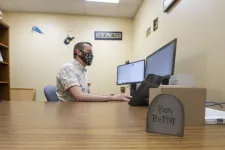(Press-News.org) To observe the swift neuronal signals in a fish brain, scientists have started to use a technique called light-field microscopy, which makes it possible to image such fast biological processes in 3D. But the images are often lacking in quality, and it takes hours or days for massive amounts of data to be converted into 3D volumes and movies.
Now, EMBL scientists have combined artificial intelligence (AI) algorithms with two cutting-edge microscopy techniques - an advance that shortens the time for image processing from days to mere seconds, while ensuring that the resulting images are crisp and accurate. The findings are published in Nature Methods.
"Ultimately, we were able to take 'the best of both worlds' in this approach," says Nils Wagner, one of the paper's two lead authors and now a PhD student at the Technical University of Munich. "AI enabled us to combine different microscopy techniques, so that we could image as fast as light-field microscopy allows and get close to the image resolution of light-sheet microscopy."
Although light-sheet microscopy and light-field microscopy sound similar, these techniques have different advantages and challenges. Light-field microscopy captures large 3D images that allow researchers to track and measure remarkably fine movements, such as a fish larva's beating heart, at very high speeds. But this technique produces massive amounts of data, which can take days to process, and the final images usually lack resolution.
Light-sheet microscopy homes in on a single 2D plane of a given sample at one time, so researchers can image samples at higher resolution. Compared with light-field microscopy, light-sheet microscopy produces images that are quicker to process, but the data are not as comprehensive, since they only capture information from a single 2D plane at a time.
To take advantage of the benefits of each technique, EMBL researchers developed an approach that uses light-field microscopy to image large 3D samples and light-sheet microscopy to train the AI algorithms, which then create an accurate 3D picture of the sample.
"If you build algorithms that produce an image, you need to check that these algorithms are constructing the right image," explains Anna Kreshuk, the EMBL group leader whose team brought machine learning expertise to the project. In the new study, the researchers used light-sheet microscopy to make sure the AI algorithms were working, Anna says. "This makes our research stand out from what has been done in the past."
Robert Prevedel, the EMBL group leader whose group contributed the novel hybrid microscopy platform, notes that the real bottleneck in building better microscopes often isn't optics technology, but computation. That's why, back in 2018, he and Anna decided to join forces. "Our method will be really key for people who want to study how brains compute. Our method can image an entire brain of a fish larva, in real time," Robert says.
He and Anna say this approach could potentially be modified to work with different types of microscopes too, eventually allowing biologists to look at dozens of different specimens and see much more, much faster. For example, it could help to find genes that are involved in heart development, or could measure the activity of thousands of neurons at the same time.
Next, the researchers plan to explore whether the method can be applied to larger species, including mammals.
INFORMATION:
Study co-lead author Fynn Beuttenmüller, a PhD student in the Kreshuk group at EMBL Heidelberg, has no doubts about the power of AI. "Computational methods will continue to bring exciting advances to microscopy."
PHILADELPHIA-- A gene called GAS2 plays a key role in normal hearing, and its absence causes severe hearing loss, according to a study led by researchers in the Perelman School of Medicine at the University of Pennsylvania.
The researchers, whose findings are published online today in Developmental Cell, discovered that the protein encoded by GAS2 is crucial for maintaining the structural stiffness of support cells in the inner ear that normally help amplify incoming sound waves. They showed that inner ear support cells lacking functional GAS2 lose their amplifier abilities, causing severe hearing ...
Depressive symptoms are more common in teenage girls than in their male peers. However, boys' mental health appears to be affected more if they suffer from obesity. Irrespective of gender, bullying is a considerably greater risk factor than overweight for developing depressive symptoms. These conclusions are drawn by researchers at Uppsala University who monitored adolescents for six years in a questionnaire study, now published in the Journal of Public Health.
Peer-review/Observational study/People
"The purpose of our study was to investigate the connection ...
Nearly four-fifths of 16- and 17-year-olds have encountered pornographic content on the Internet
Pornography is a multibillion-dollar business. Pornographic content is virtually ubiquitous on the Internet, and surveys suggest that 25% of all searches lead to explicit content. Given the size of the market, it's not surprising that young people are drawn to such sites, which are only a couple of clicks away.
Professor Neil Thurman of the Department of Media and Communication (IfKW) at Ludwig-Maximilians-Universitaet (LMU) in Munich, in collaboration with statistician Fabian Obster (Universität der Bundeswehr München), has carried out a study on the use of pornographic sites by young people. Based on a survey involving a sample ...
Great reed warblers normally migrate by night during its month-long migration from northern Europe to Sub-Saharan Africa. However, researchers have now discovered that during the few occasions when it continues to fly during daytime, it flies at extremely high altitudes (up to 6300 meters). One possible explanation for this unexpected and consistent behaviour could be that the birds want to avoid overheating. The study is published in Science.
Most of the many millions of songbirds that migrate every year between Europe and Africa fly by night and spend the daytime hours resting and eating. Some species, which normally only fly by night, occasionally fly for over 24 consecutive ...
If you are reading this, chances are you have several other tabs open in your browser that you mean to get to eventually.
Internet browser tabs are a major source of friction on the internet. People love them. People hate them. For some users, tabs bring order and efficiency to their web browsing. For others, they spiral out of control, shrinking at the top of the screen as their numbers expand.
A research team at Carnegie Mellon University recently completed the first in-depth study of browser tabs in more than a decade. They found that many people struggle with tab overload, an underlying reason being that while tabs serve a variety of functions, ...
ITHACA, N.Y. - An 18.5 million-year-old fossil found in Panama provides evidence of a new species and is the oldest reliable example of a climbing woody vine known as a liana from the soapberry family. The discovery sheds light on the evolution of climbing plants.
The new species, named Ampelorhiza heteroxylon, belongs to a diverse group of tropical lianas called Paullinieae, within the soapberry family (Sapindaceae). More than 475 species of Paullinieae live in the tropics today.
Researchers identified the species from fossilized roots that revealed features known to be unique to the wood of modern climbing vines, adaptations that allow them to twist, grow and climb.
The study, "Climbing ...
The functions of water-dominated ecosystems can be considerably influenced and changed by hydrological fluctuation. The varying states of redox-active substances are of crucial importance here. Researchers at the University of Bayreuth have discovered this, in cooperation with partners from the Universities of Tübingen and Bristol and the Helmholtz Centre for Environmental Research, Halle-Leipzig. They present their discovery in the journal Nature Geoscience. The new study enables a more precise understanding of the biogeochemical processes that contribute to the degradation of pollutants and the reduction of greenhouse gas ...
More than ever, patients are using telehealth to ask doctors and nurses about worrying blood-pressure readings, nauseating migraines and stubborn foot ulcers. But for patients with chronic conditions, how frequent should telehealth appointments be? Can that frequency change? Under what conditions?
West Virginia University researcher Jennifer Mallow is trying to answer these questions. In a new project, she and her colleagues completed a systematic review of studies that dealt with telehealth and chronic conditions. They found that--in general--telehealth services benefitted patients more if they ...
A comprehensive review into what we know about COVID-19 and the way it functions suggests the virus has a unique infectious profile, which explains why it can be so hard to treat and why some people experience so-called "long-COVID", struggling with significant health issues months after infection.
There is growing evidence that the virus infects both the upper and lower respiratory tracts - unlike "low pathogenic" human coronavirus sub-species, which typically settle in the upper respiratory tract and cause cold-like symptoms, or "high pathogenic" viruses such as those that cause SARS and ARDS, which typically settle in the lower respiratory tract.
Additionally, more frequent multi-organ impacts, and blood clots, and ...
Which wound cuts deeper: the loss of an only child or loss of a spouse? A new study led by researchers at NYU Rory Meyers College of Nursing and Fudan University suggests that Chinese parents find the loss of an only child to be approximately 1.3 times as psychologically distressing than the loss of a spouse. The findings are published in the journal Aging & Mental Health.
Older adults in China rely heavily on family support, particularly from their adult children. Filial piety--the Confucian idea describing a respect for one's parents and responsibility for adult children to care for ...


